Understanding and Leading Change: A Case Study of Marks & Spencer
VerifiedAdded on 2024/05/31
|17
|4834
|283
AI Summary
This study examines the challenges faced by Marks & Spencer in navigating a period of significant change. It explores the impacts of change on organizational strategy and operations, identifies key drivers of change, and analyzes how barriers to change influence leadership decision-making. The study also applies a range of leadership approaches to the change initiative, drawing on theories such as the Hersey Blanchard Situational Leadership model and Kotter's 8-Step Model. Through a detailed analysis of Marks & Spencer's case, the study provides insights into the complexities of managing change within a large organization.
Contribute Materials
Your contribution can guide someone’s learning journey. Share your
documents today.
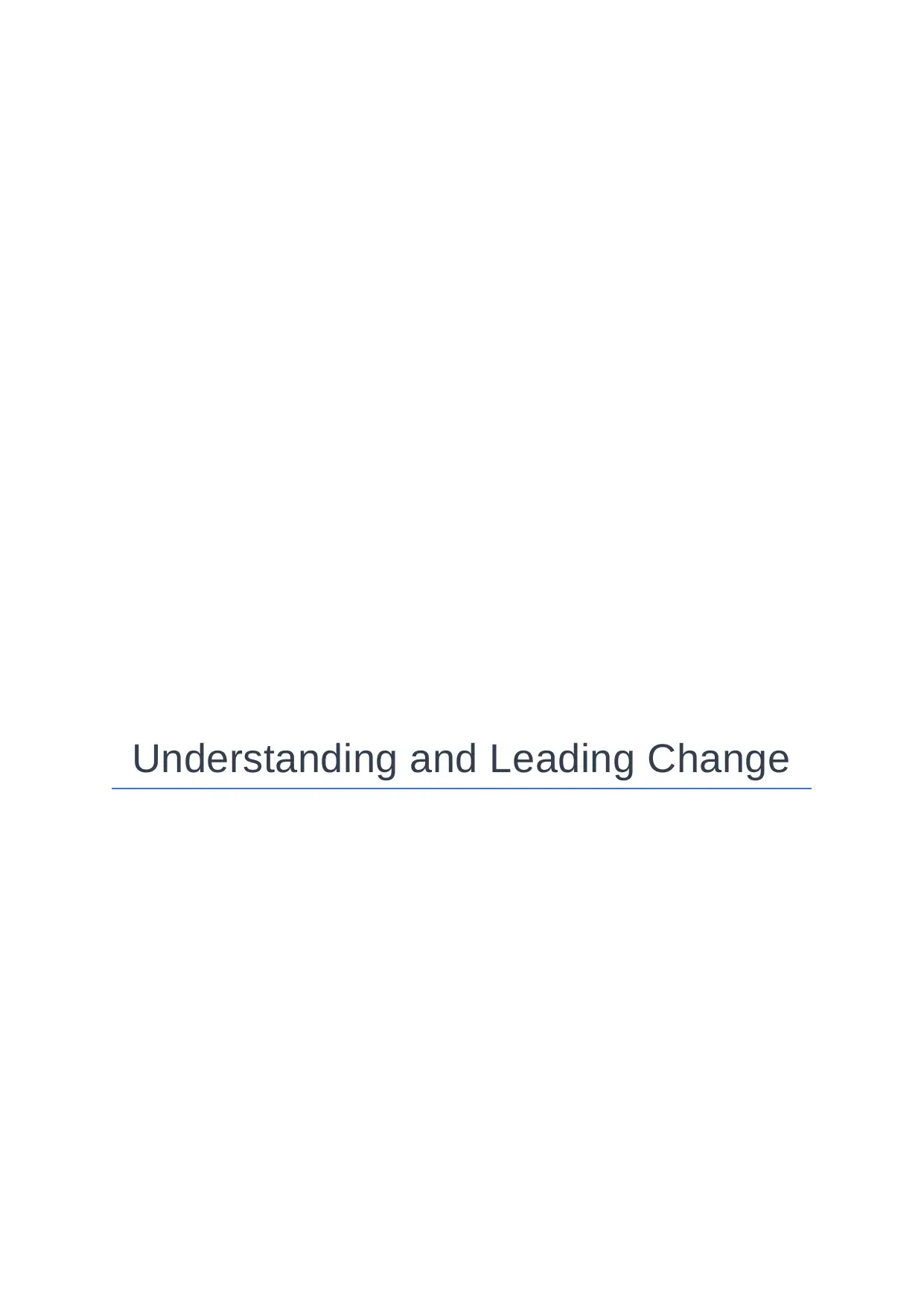
Understanding and Leading Change
Secure Best Marks with AI Grader
Need help grading? Try our AI Grader for instant feedback on your assignments.
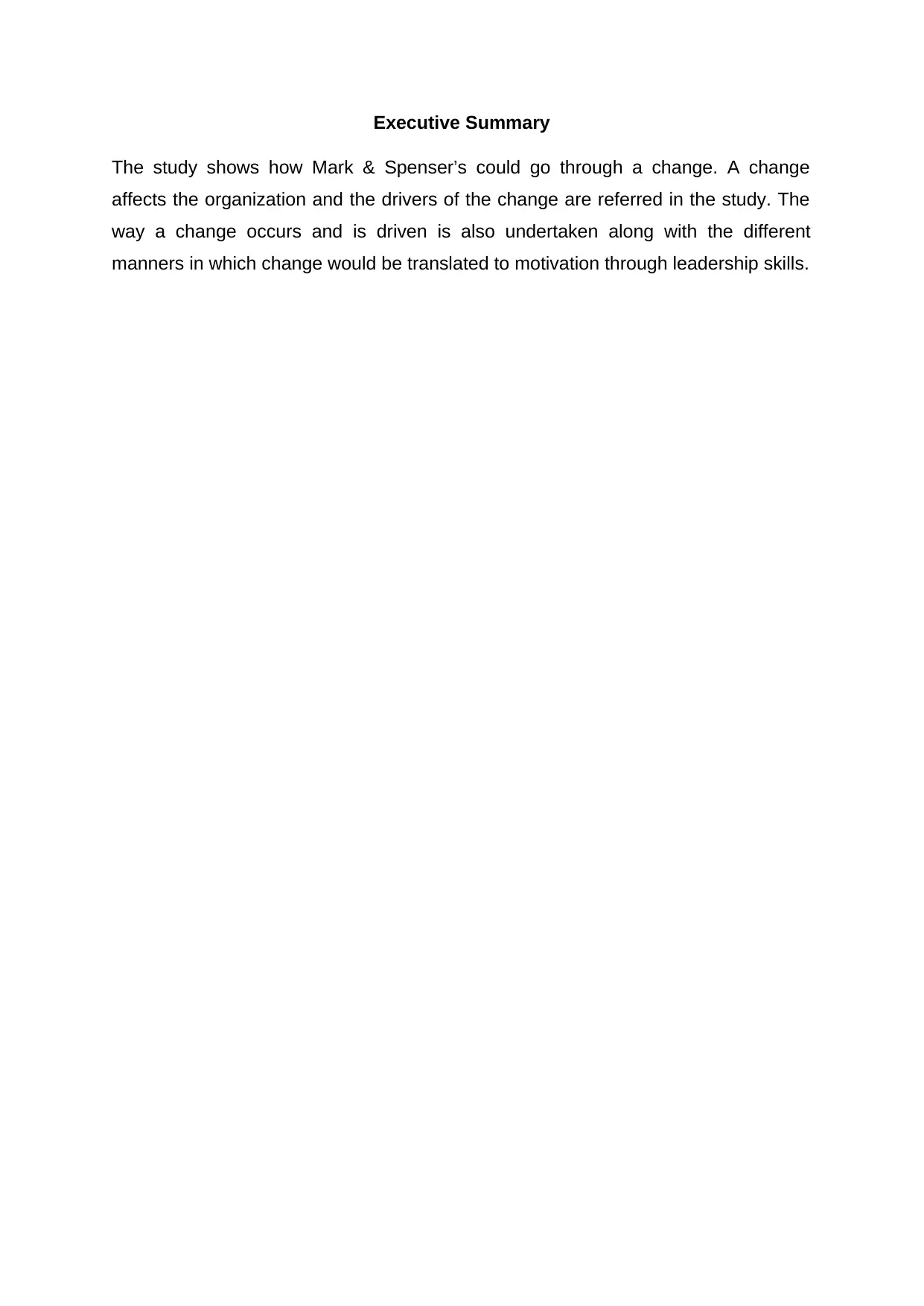
Executive Summary
The study shows how Mark & Spenser’s could go through a change. A change
affects the organization and the drivers of the change are referred in the study. The
way a change occurs and is driven is also undertaken along with the different
manners in which change would be translated to motivation through leadership skills.
The study shows how Mark & Spenser’s could go through a change. A change
affects the organization and the drivers of the change are referred in the study. The
way a change occurs and is driven is also undertaken along with the different
manners in which change would be translated to motivation through leadership skills.
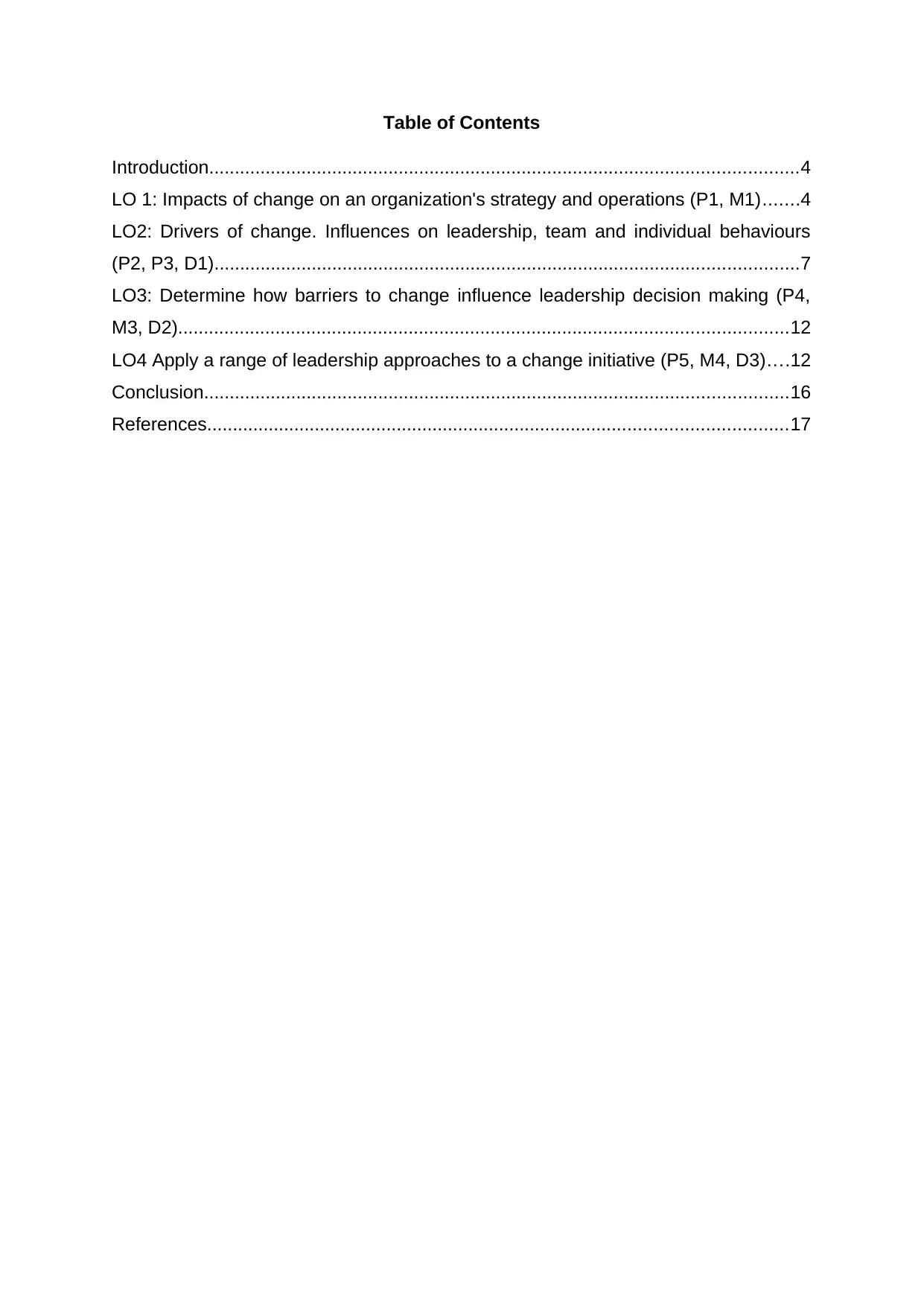
Table of Contents
Introduction...................................................................................................................4
LO 1: Impacts of change on an organization's strategy and operations (P1, M1).......4
LO2: Drivers of change. Influences on leadership, team and individual behaviours
(P2, P3, D1)..................................................................................................................7
LO3: Determine how barriers to change influence leadership decision making (P4,
M3, D2).......................................................................................................................12
LO4 Apply a range of leadership approaches to a change initiative (P5, M4, D3)....12
Conclusion..................................................................................................................16
References.................................................................................................................17
Introduction...................................................................................................................4
LO 1: Impacts of change on an organization's strategy and operations (P1, M1).......4
LO2: Drivers of change. Influences on leadership, team and individual behaviours
(P2, P3, D1)..................................................................................................................7
LO3: Determine how barriers to change influence leadership decision making (P4,
M3, D2).......................................................................................................................12
LO4 Apply a range of leadership approaches to a change initiative (P5, M4, D3)....12
Conclusion..................................................................................................................16
References.................................................................................................................17
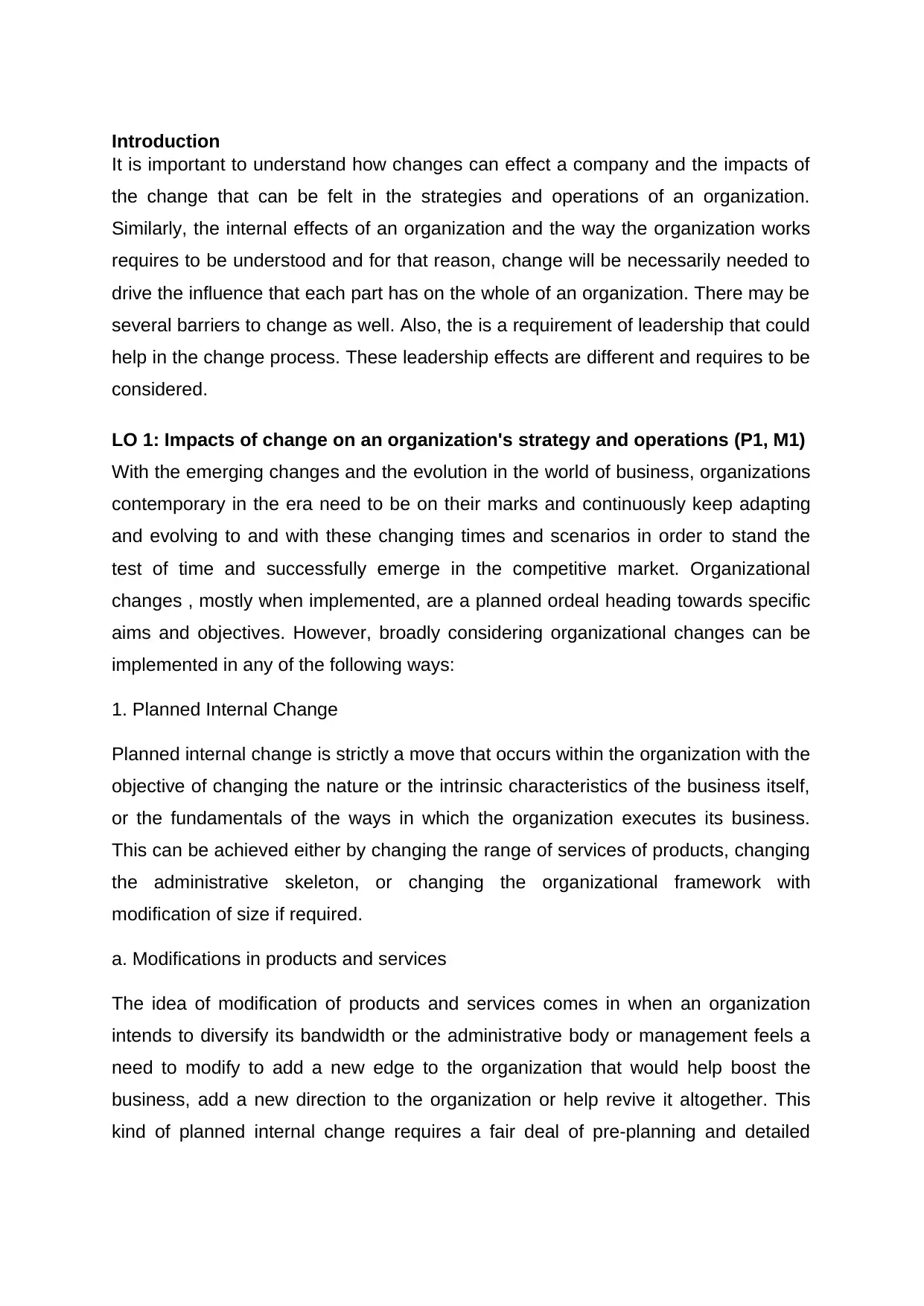
Introduction
It is important to understand how changes can effect a company and the impacts of
the change that can be felt in the strategies and operations of an organization.
Similarly, the internal effects of an organization and the way the organization works
requires to be understood and for that reason, change will be necessarily needed to
drive the influence that each part has on the whole of an organization. There may be
several barriers to change as well. Also, the is a requirement of leadership that could
help in the change process. These leadership effects are different and requires to be
considered.
LO 1: Impacts of change on an organization's strategy and operations (P1, M1)
With the emerging changes and the evolution in the world of business, organizations
contemporary in the era need to be on their marks and continuously keep adapting
and evolving to and with these changing times and scenarios in order to stand the
test of time and successfully emerge in the competitive market. Organizational
changes , mostly when implemented, are a planned ordeal heading towards specific
aims and objectives. However, broadly considering organizational changes can be
implemented in any of the following ways:
1. Planned Internal Change
Planned internal change is strictly a move that occurs within the organization with the
objective of changing the nature or the intrinsic characteristics of the business itself,
or the fundamentals of the ways in which the organization executes its business.
This can be achieved either by changing the range of services of products, changing
the administrative skeleton, or changing the organizational framework with
modification of size if required.
a. Modifications in products and services
The idea of modification of products and services comes in when an organization
intends to diversify its bandwidth or the administrative body or management feels a
need to modify to add a new edge to the organization that would help boost the
business, add a new direction to the organization or help revive it altogether. This
kind of planned internal change requires a fair deal of pre-planning and detailed
It is important to understand how changes can effect a company and the impacts of
the change that can be felt in the strategies and operations of an organization.
Similarly, the internal effects of an organization and the way the organization works
requires to be understood and for that reason, change will be necessarily needed to
drive the influence that each part has on the whole of an organization. There may be
several barriers to change as well. Also, the is a requirement of leadership that could
help in the change process. These leadership effects are different and requires to be
considered.
LO 1: Impacts of change on an organization's strategy and operations (P1, M1)
With the emerging changes and the evolution in the world of business, organizations
contemporary in the era need to be on their marks and continuously keep adapting
and evolving to and with these changing times and scenarios in order to stand the
test of time and successfully emerge in the competitive market. Organizational
changes , mostly when implemented, are a planned ordeal heading towards specific
aims and objectives. However, broadly considering organizational changes can be
implemented in any of the following ways:
1. Planned Internal Change
Planned internal change is strictly a move that occurs within the organization with the
objective of changing the nature or the intrinsic characteristics of the business itself,
or the fundamentals of the ways in which the organization executes its business.
This can be achieved either by changing the range of services of products, changing
the administrative skeleton, or changing the organizational framework with
modification of size if required.
a. Modifications in products and services
The idea of modification of products and services comes in when an organization
intends to diversify its bandwidth or the administrative body or management feels a
need to modify to add a new edge to the organization that would help boost the
business, add a new direction to the organization or help revive it altogether. This
kind of planned internal change requires a fair deal of pre-planning and detailed
Secure Best Marks with AI Grader
Need help grading? Try our AI Grader for instant feedback on your assignments.
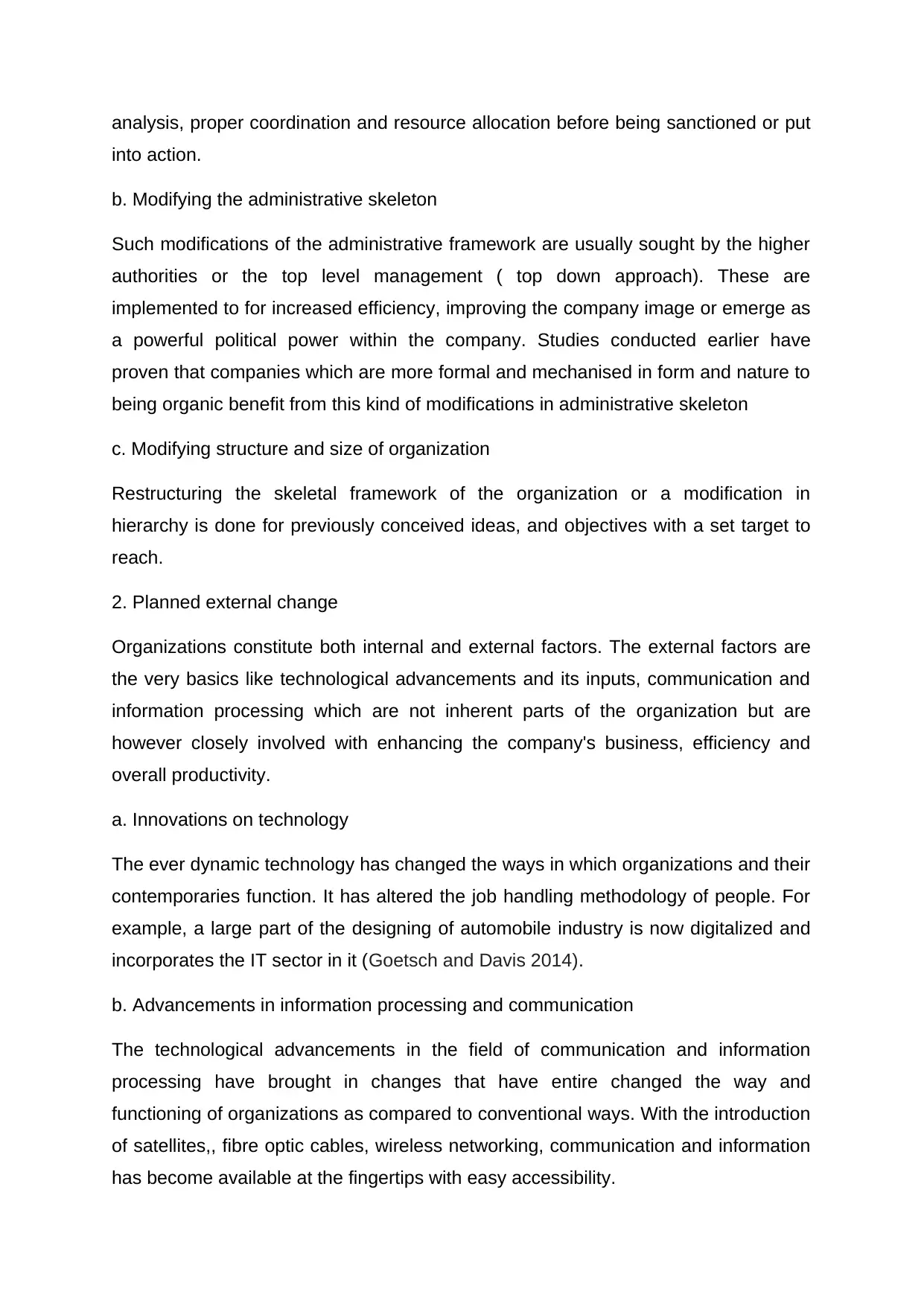
analysis, proper coordination and resource allocation before being sanctioned or put
into action.
b. Modifying the administrative skeleton
Such modifications of the administrative framework are usually sought by the higher
authorities or the top level management ( top down approach). These are
implemented to for increased efficiency, improving the company image or emerge as
a powerful political power within the company. Studies conducted earlier have
proven that companies which are more formal and mechanised in form and nature to
being organic benefit from this kind of modifications in administrative skeleton
c. Modifying structure and size of organization
Restructuring the skeletal framework of the organization or a modification in
hierarchy is done for previously conceived ideas, and objectives with a set target to
reach.
2. Planned external change
Organizations constitute both internal and external factors. The external factors are
the very basics like technological advancements and its inputs, communication and
information processing which are not inherent parts of the organization but are
however closely involved with enhancing the company's business, efficiency and
overall productivity.
a. Innovations on technology
The ever dynamic technology has changed the ways in which organizations and their
contemporaries function. It has altered the job handling methodology of people. For
example, a large part of the designing of automobile industry is now digitalized and
incorporates the IT sector in it (Goetsch and Davis 2014).
b. Advancements in information processing and communication
The technological advancements in the field of communication and information
processing have brought in changes that have entire changed the way and
functioning of organizations as compared to conventional ways. With the introduction
of satellites,, fibre optic cables, wireless networking, communication and information
has become available at the fingertips with easy accessibility.
into action.
b. Modifying the administrative skeleton
Such modifications of the administrative framework are usually sought by the higher
authorities or the top level management ( top down approach). These are
implemented to for increased efficiency, improving the company image or emerge as
a powerful political power within the company. Studies conducted earlier have
proven that companies which are more formal and mechanised in form and nature to
being organic benefit from this kind of modifications in administrative skeleton
c. Modifying structure and size of organization
Restructuring the skeletal framework of the organization or a modification in
hierarchy is done for previously conceived ideas, and objectives with a set target to
reach.
2. Planned external change
Organizations constitute both internal and external factors. The external factors are
the very basics like technological advancements and its inputs, communication and
information processing which are not inherent parts of the organization but are
however closely involved with enhancing the company's business, efficiency and
overall productivity.
a. Innovations on technology
The ever dynamic technology has changed the ways in which organizations and their
contemporaries function. It has altered the job handling methodology of people. For
example, a large part of the designing of automobile industry is now digitalized and
incorporates the IT sector in it (Goetsch and Davis 2014).
b. Advancements in information processing and communication
The technological advancements in the field of communication and information
processing have brought in changes that have entire changed the way and
functioning of organizations as compared to conventional ways. With the introduction
of satellites,, fibre optic cables, wireless networking, communication and information
has become available at the fingertips with easy accessibility.
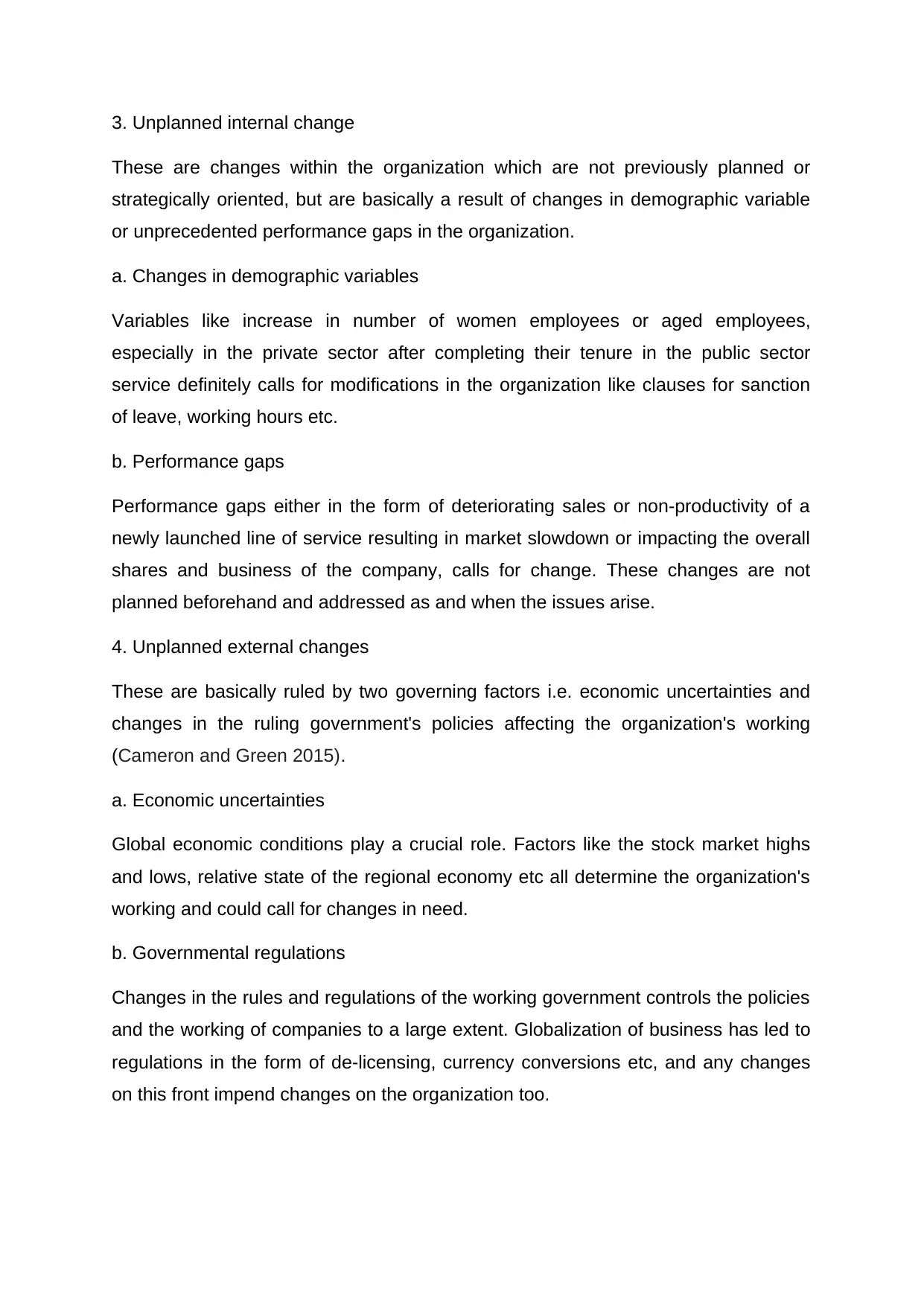
3. Unplanned internal change
These are changes within the organization which are not previously planned or
strategically oriented, but are basically a result of changes in demographic variable
or unprecedented performance gaps in the organization.
a. Changes in demographic variables
Variables like increase in number of women employees or aged employees,
especially in the private sector after completing their tenure in the public sector
service definitely calls for modifications in the organization like clauses for sanction
of leave, working hours etc.
b. Performance gaps
Performance gaps either in the form of deteriorating sales or non-productivity of a
newly launched line of service resulting in market slowdown or impacting the overall
shares and business of the company, calls for change. These changes are not
planned beforehand and addressed as and when the issues arise.
4. Unplanned external changes
These are basically ruled by two governing factors i.e. economic uncertainties and
changes in the ruling government's policies affecting the organization's working
(Cameron and Green 2015).
a. Economic uncertainties
Global economic conditions play a crucial role. Factors like the stock market highs
and lows, relative state of the regional economy etc all determine the organization's
working and could call for changes in need.
b. Governmental regulations
Changes in the rules and regulations of the working government controls the policies
and the working of companies to a large extent. Globalization of business has led to
regulations in the form of de-licensing, currency conversions etc, and any changes
on this front impend changes on the organization too.
These are changes within the organization which are not previously planned or
strategically oriented, but are basically a result of changes in demographic variable
or unprecedented performance gaps in the organization.
a. Changes in demographic variables
Variables like increase in number of women employees or aged employees,
especially in the private sector after completing their tenure in the public sector
service definitely calls for modifications in the organization like clauses for sanction
of leave, working hours etc.
b. Performance gaps
Performance gaps either in the form of deteriorating sales or non-productivity of a
newly launched line of service resulting in market slowdown or impacting the overall
shares and business of the company, calls for change. These changes are not
planned beforehand and addressed as and when the issues arise.
4. Unplanned external changes
These are basically ruled by two governing factors i.e. economic uncertainties and
changes in the ruling government's policies affecting the organization's working
(Cameron and Green 2015).
a. Economic uncertainties
Global economic conditions play a crucial role. Factors like the stock market highs
and lows, relative state of the regional economy etc all determine the organization's
working and could call for changes in need.
b. Governmental regulations
Changes in the rules and regulations of the working government controls the policies
and the working of companies to a large extent. Globalization of business has led to
regulations in the form of de-licensing, currency conversions etc, and any changes
on this front impend changes on the organization too.
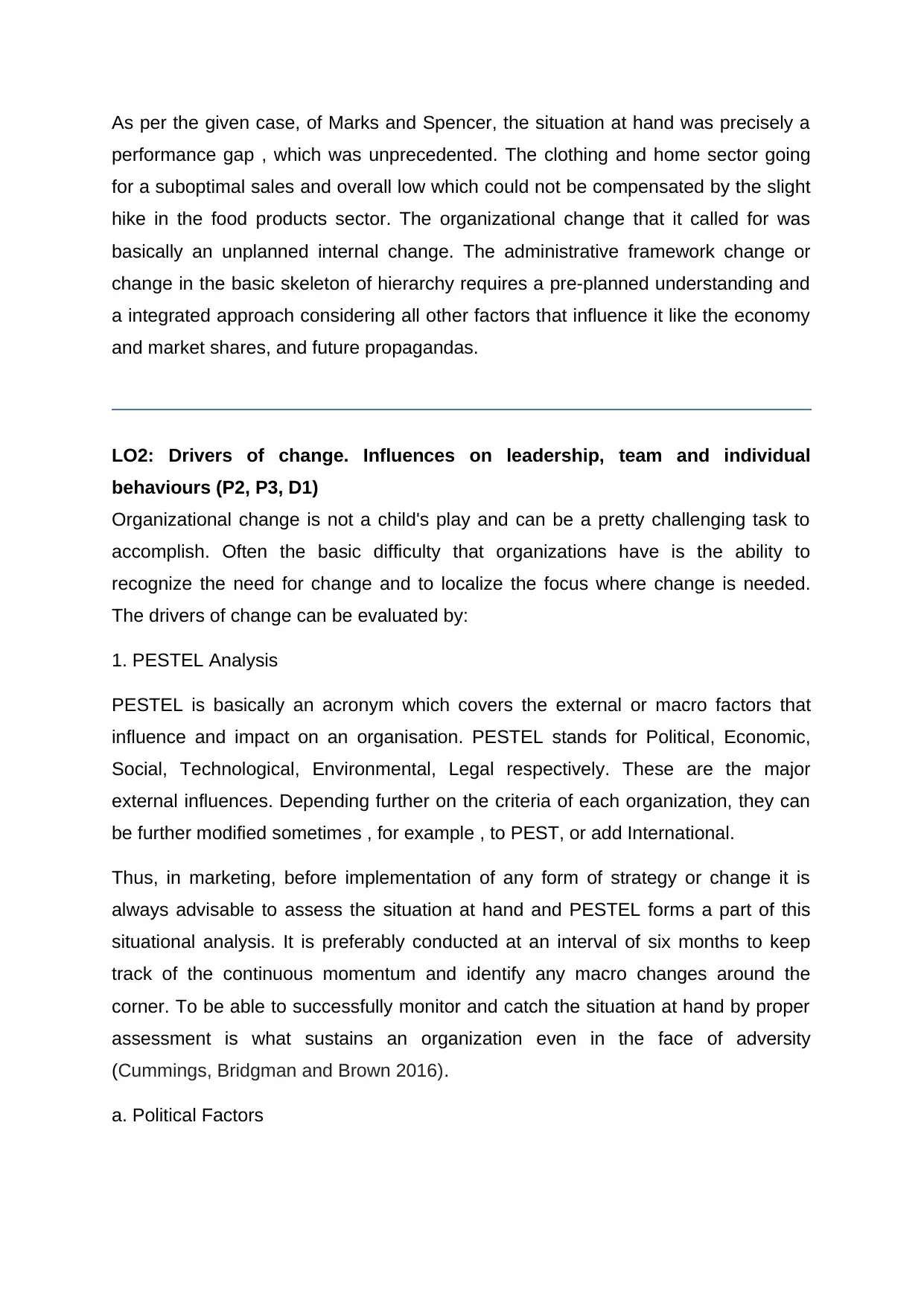
As per the given case, of Marks and Spencer, the situation at hand was precisely a
performance gap , which was unprecedented. The clothing and home sector going
for a suboptimal sales and overall low which could not be compensated by the slight
hike in the food products sector. The organizational change that it called for was
basically an unplanned internal change. The administrative framework change or
change in the basic skeleton of hierarchy requires a pre-planned understanding and
a integrated approach considering all other factors that influence it like the economy
and market shares, and future propagandas.
LO2: Drivers of change. Influences on leadership, team and individual
behaviours (P2, P3, D1)
Organizational change is not a child's play and can be a pretty challenging task to
accomplish. Often the basic difficulty that organizations have is the ability to
recognize the need for change and to localize the focus where change is needed.
The drivers of change can be evaluated by:
1. PESTEL Analysis
PESTEL is basically an acronym which covers the external or macro factors that
influence and impact on an organisation. PESTEL stands for Political, Economic,
Social, Technological, Environmental, Legal respectively. These are the major
external influences. Depending further on the criteria of each organization, they can
be further modified sometimes , for example , to PEST, or add International.
Thus, in marketing, before implementation of any form of strategy or change it is
always advisable to assess the situation at hand and PESTEL forms a part of this
situational analysis. It is preferably conducted at an interval of six months to keep
track of the continuous momentum and identify any macro changes around the
corner. To be able to successfully monitor and catch the situation at hand by proper
assessment is what sustains an organization even in the face of adversity
(Cummings, Bridgman and Brown 2016).
a. Political Factors
performance gap , which was unprecedented. The clothing and home sector going
for a suboptimal sales and overall low which could not be compensated by the slight
hike in the food products sector. The organizational change that it called for was
basically an unplanned internal change. The administrative framework change or
change in the basic skeleton of hierarchy requires a pre-planned understanding and
a integrated approach considering all other factors that influence it like the economy
and market shares, and future propagandas.
LO2: Drivers of change. Influences on leadership, team and individual
behaviours (P2, P3, D1)
Organizational change is not a child's play and can be a pretty challenging task to
accomplish. Often the basic difficulty that organizations have is the ability to
recognize the need for change and to localize the focus where change is needed.
The drivers of change can be evaluated by:
1. PESTEL Analysis
PESTEL is basically an acronym which covers the external or macro factors that
influence and impact on an organisation. PESTEL stands for Political, Economic,
Social, Technological, Environmental, Legal respectively. These are the major
external influences. Depending further on the criteria of each organization, they can
be further modified sometimes , for example , to PEST, or add International.
Thus, in marketing, before implementation of any form of strategy or change it is
always advisable to assess the situation at hand and PESTEL forms a part of this
situational analysis. It is preferably conducted at an interval of six months to keep
track of the continuous momentum and identify any macro changes around the
corner. To be able to successfully monitor and catch the situation at hand by proper
assessment is what sustains an organization even in the face of adversity
(Cummings, Bridgman and Brown 2016).
a. Political Factors
Paraphrase This Document
Need a fresh take? Get an instant paraphrase of this document with our AI Paraphraser
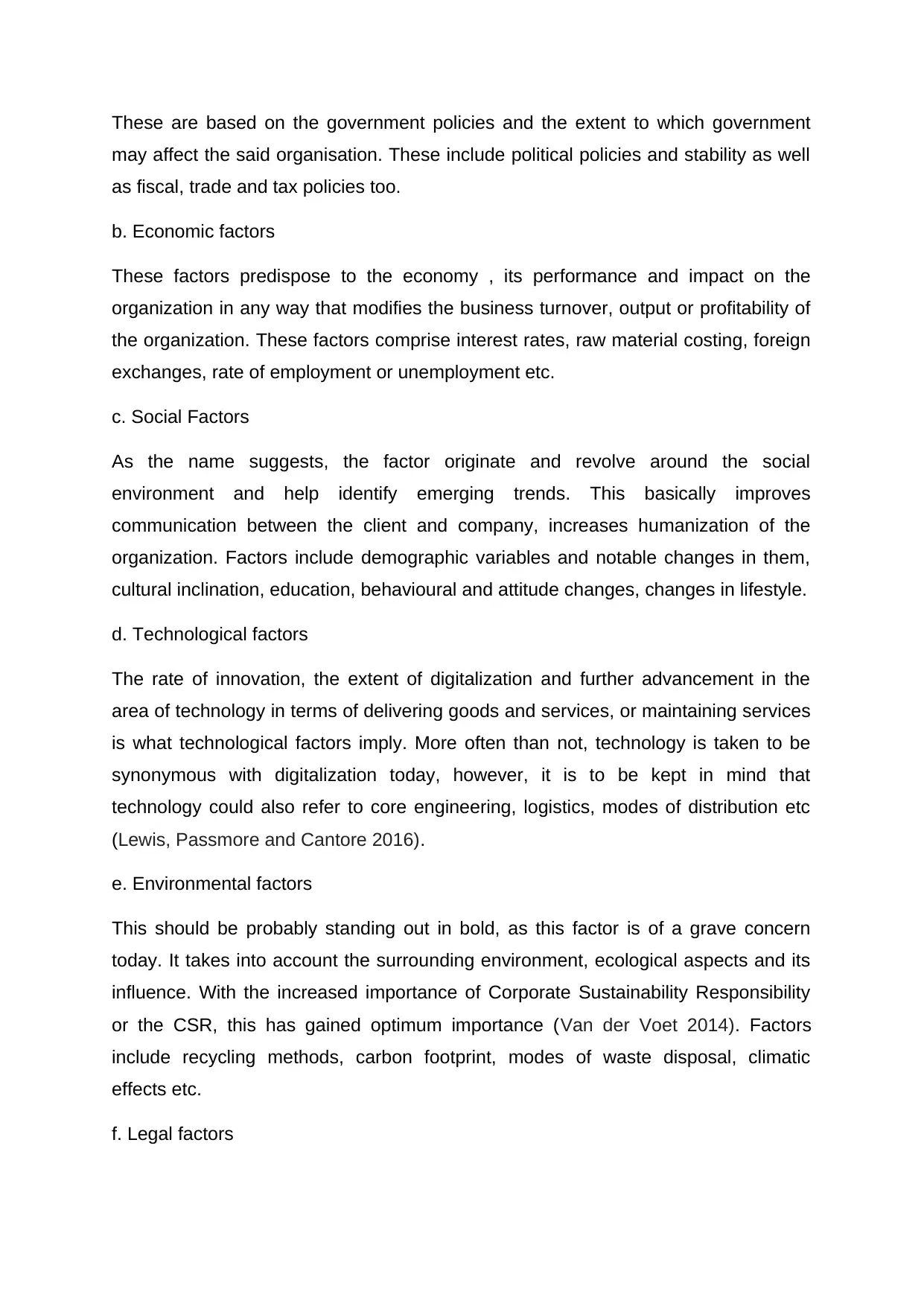
These are based on the government policies and the extent to which government
may affect the said organisation. These include political policies and stability as well
as fiscal, trade and tax policies too.
b. Economic factors
These factors predispose to the economy , its performance and impact on the
organization in any way that modifies the business turnover, output or profitability of
the organization. These factors comprise interest rates, raw material costing, foreign
exchanges, rate of employment or unemployment etc.
c. Social Factors
As the name suggests, the factor originate and revolve around the social
environment and help identify emerging trends. This basically improves
communication between the client and company, increases humanization of the
organization. Factors include demographic variables and notable changes in them,
cultural inclination, education, behavioural and attitude changes, changes in lifestyle.
d. Technological factors
The rate of innovation, the extent of digitalization and further advancement in the
area of technology in terms of delivering goods and services, or maintaining services
is what technological factors imply. More often than not, technology is taken to be
synonymous with digitalization today, however, it is to be kept in mind that
technology could also refer to core engineering, logistics, modes of distribution etc
(Lewis, Passmore and Cantore 2016).
e. Environmental factors
This should be probably standing out in bold, as this factor is of a grave concern
today. It takes into account the surrounding environment, ecological aspects and its
influence. With the increased importance of Corporate Sustainability Responsibility
or the CSR, this has gained optimum importance (Van der Voet 2014). Factors
include recycling methods, carbon footprint, modes of waste disposal, climatic
effects etc.
f. Legal factors
may affect the said organisation. These include political policies and stability as well
as fiscal, trade and tax policies too.
b. Economic factors
These factors predispose to the economy , its performance and impact on the
organization in any way that modifies the business turnover, output or profitability of
the organization. These factors comprise interest rates, raw material costing, foreign
exchanges, rate of employment or unemployment etc.
c. Social Factors
As the name suggests, the factor originate and revolve around the social
environment and help identify emerging trends. This basically improves
communication between the client and company, increases humanization of the
organization. Factors include demographic variables and notable changes in them,
cultural inclination, education, behavioural and attitude changes, changes in lifestyle.
d. Technological factors
The rate of innovation, the extent of digitalization and further advancement in the
area of technology in terms of delivering goods and services, or maintaining services
is what technological factors imply. More often than not, technology is taken to be
synonymous with digitalization today, however, it is to be kept in mind that
technology could also refer to core engineering, logistics, modes of distribution etc
(Lewis, Passmore and Cantore 2016).
e. Environmental factors
This should be probably standing out in bold, as this factor is of a grave concern
today. It takes into account the surrounding environment, ecological aspects and its
influence. With the increased importance of Corporate Sustainability Responsibility
or the CSR, this has gained optimum importance (Van der Voet 2014). Factors
include recycling methods, carbon footprint, modes of waste disposal, climatic
effects etc.
f. Legal factors
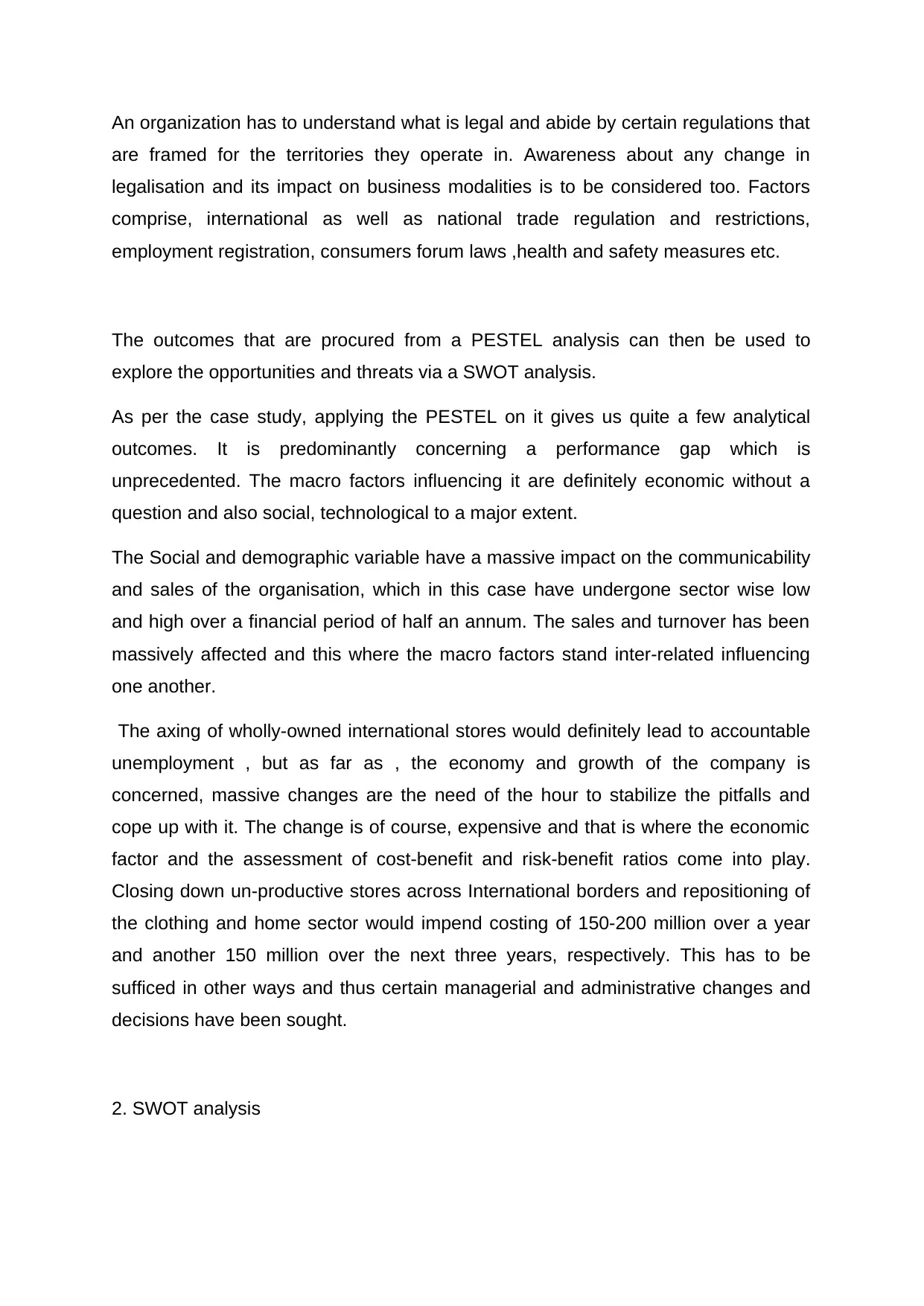
An organization has to understand what is legal and abide by certain regulations that
are framed for the territories they operate in. Awareness about any change in
legalisation and its impact on business modalities is to be considered too. Factors
comprise, international as well as national trade regulation and restrictions,
employment registration, consumers forum laws ,health and safety measures etc.
The outcomes that are procured from a PESTEL analysis can then be used to
explore the opportunities and threats via a SWOT analysis.
As per the case study, applying the PESTEL on it gives us quite a few analytical
outcomes. It is predominantly concerning a performance gap which is
unprecedented. The macro factors influencing it are definitely economic without a
question and also social, technological to a major extent.
The Social and demographic variable have a massive impact on the communicability
and sales of the organisation, which in this case have undergone sector wise low
and high over a financial period of half an annum. The sales and turnover has been
massively affected and this where the macro factors stand inter-related influencing
one another.
The axing of wholly-owned international stores would definitely lead to accountable
unemployment , but as far as , the economy and growth of the company is
concerned, massive changes are the need of the hour to stabilize the pitfalls and
cope up with it. The change is of course, expensive and that is where the economic
factor and the assessment of cost-benefit and risk-benefit ratios come into play.
Closing down un-productive stores across International borders and repositioning of
the clothing and home sector would impend costing of 150-200 million over a year
and another 150 million over the next three years, respectively. This has to be
sufficed in other ways and thus certain managerial and administrative changes and
decisions have been sought.
2. SWOT analysis
are framed for the territories they operate in. Awareness about any change in
legalisation and its impact on business modalities is to be considered too. Factors
comprise, international as well as national trade regulation and restrictions,
employment registration, consumers forum laws ,health and safety measures etc.
The outcomes that are procured from a PESTEL analysis can then be used to
explore the opportunities and threats via a SWOT analysis.
As per the case study, applying the PESTEL on it gives us quite a few analytical
outcomes. It is predominantly concerning a performance gap which is
unprecedented. The macro factors influencing it are definitely economic without a
question and also social, technological to a major extent.
The Social and demographic variable have a massive impact on the communicability
and sales of the organisation, which in this case have undergone sector wise low
and high over a financial period of half an annum. The sales and turnover has been
massively affected and this where the macro factors stand inter-related influencing
one another.
The axing of wholly-owned international stores would definitely lead to accountable
unemployment , but as far as , the economy and growth of the company is
concerned, massive changes are the need of the hour to stabilize the pitfalls and
cope up with it. The change is of course, expensive and that is where the economic
factor and the assessment of cost-benefit and risk-benefit ratios come into play.
Closing down un-productive stores across International borders and repositioning of
the clothing and home sector would impend costing of 150-200 million over a year
and another 150 million over the next three years, respectively. This has to be
sufficed in other ways and thus certain managerial and administrative changes and
decisions have been sought.
2. SWOT analysis
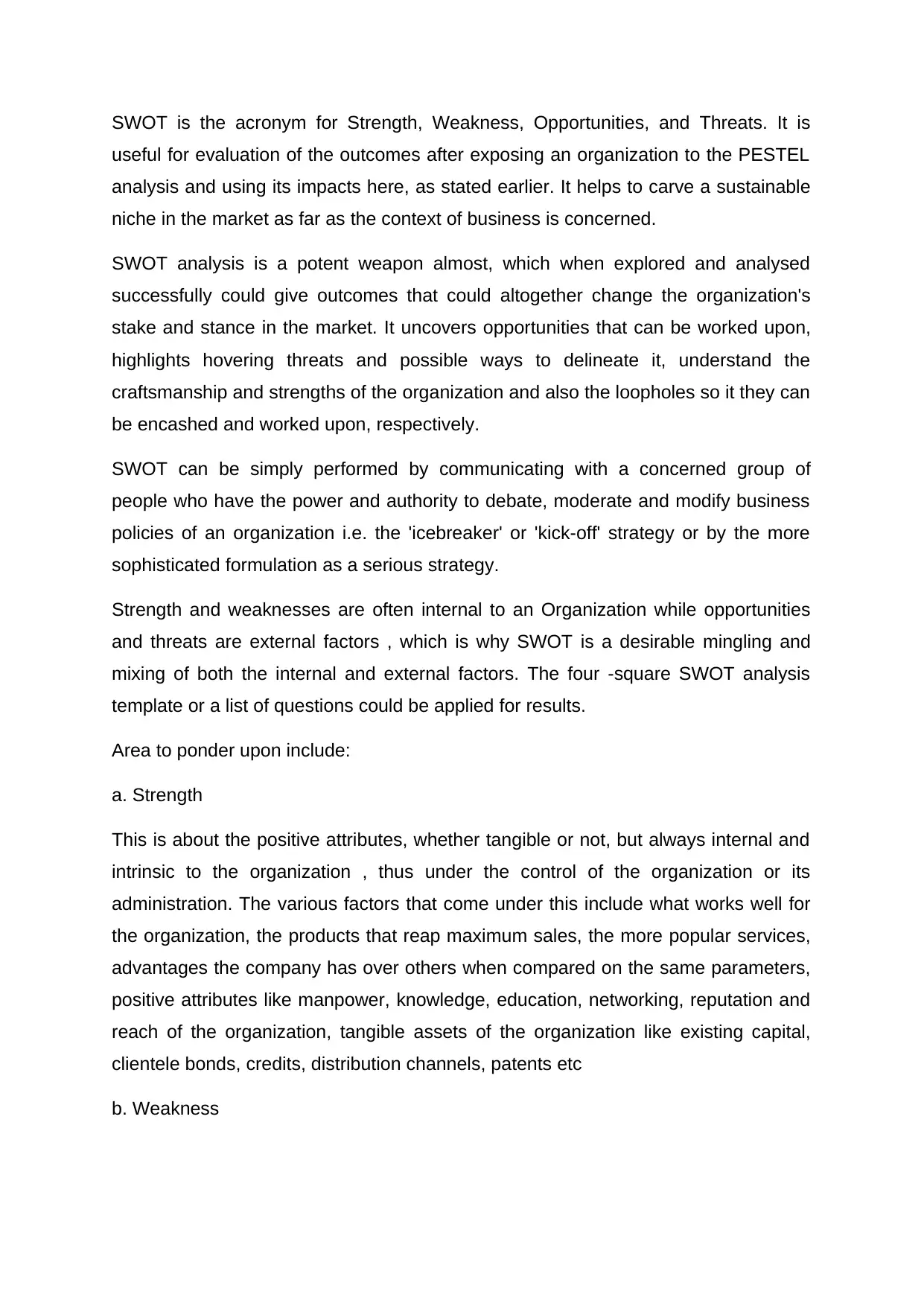
SWOT is the acronym for Strength, Weakness, Opportunities, and Threats. It is
useful for evaluation of the outcomes after exposing an organization to the PESTEL
analysis and using its impacts here, as stated earlier. It helps to carve a sustainable
niche in the market as far as the context of business is concerned.
SWOT analysis is a potent weapon almost, which when explored and analysed
successfully could give outcomes that could altogether change the organization's
stake and stance in the market. It uncovers opportunities that can be worked upon,
highlights hovering threats and possible ways to delineate it, understand the
craftsmanship and strengths of the organization and also the loopholes so it they can
be encashed and worked upon, respectively.
SWOT can be simply performed by communicating with a concerned group of
people who have the power and authority to debate, moderate and modify business
policies of an organization i.e. the 'icebreaker' or 'kick-off' strategy or by the more
sophisticated formulation as a serious strategy.
Strength and weaknesses are often internal to an Organization while opportunities
and threats are external factors , which is why SWOT is a desirable mingling and
mixing of both the internal and external factors. The four -square SWOT analysis
template or a list of questions could be applied for results.
Area to ponder upon include:
a. Strength
This is about the positive attributes, whether tangible or not, but always internal and
intrinsic to the organization , thus under the control of the organization or its
administration. The various factors that come under this include what works well for
the organization, the products that reap maximum sales, the more popular services,
advantages the company has over others when compared on the same parameters,
positive attributes like manpower, knowledge, education, networking, reputation and
reach of the organization, tangible assets of the organization like existing capital,
clientele bonds, credits, distribution channels, patents etc
b. Weakness
useful for evaluation of the outcomes after exposing an organization to the PESTEL
analysis and using its impacts here, as stated earlier. It helps to carve a sustainable
niche in the market as far as the context of business is concerned.
SWOT analysis is a potent weapon almost, which when explored and analysed
successfully could give outcomes that could altogether change the organization's
stake and stance in the market. It uncovers opportunities that can be worked upon,
highlights hovering threats and possible ways to delineate it, understand the
craftsmanship and strengths of the organization and also the loopholes so it they can
be encashed and worked upon, respectively.
SWOT can be simply performed by communicating with a concerned group of
people who have the power and authority to debate, moderate and modify business
policies of an organization i.e. the 'icebreaker' or 'kick-off' strategy or by the more
sophisticated formulation as a serious strategy.
Strength and weaknesses are often internal to an Organization while opportunities
and threats are external factors , which is why SWOT is a desirable mingling and
mixing of both the internal and external factors. The four -square SWOT analysis
template or a list of questions could be applied for results.
Area to ponder upon include:
a. Strength
This is about the positive attributes, whether tangible or not, but always internal and
intrinsic to the organization , thus under the control of the organization or its
administration. The various factors that come under this include what works well for
the organization, the products that reap maximum sales, the more popular services,
advantages the company has over others when compared on the same parameters,
positive attributes like manpower, knowledge, education, networking, reputation and
reach of the organization, tangible assets of the organization like existing capital,
clientele bonds, credits, distribution channels, patents etc
b. Weakness
Secure Best Marks with AI Grader
Need help grading? Try our AI Grader for instant feedback on your assignments.
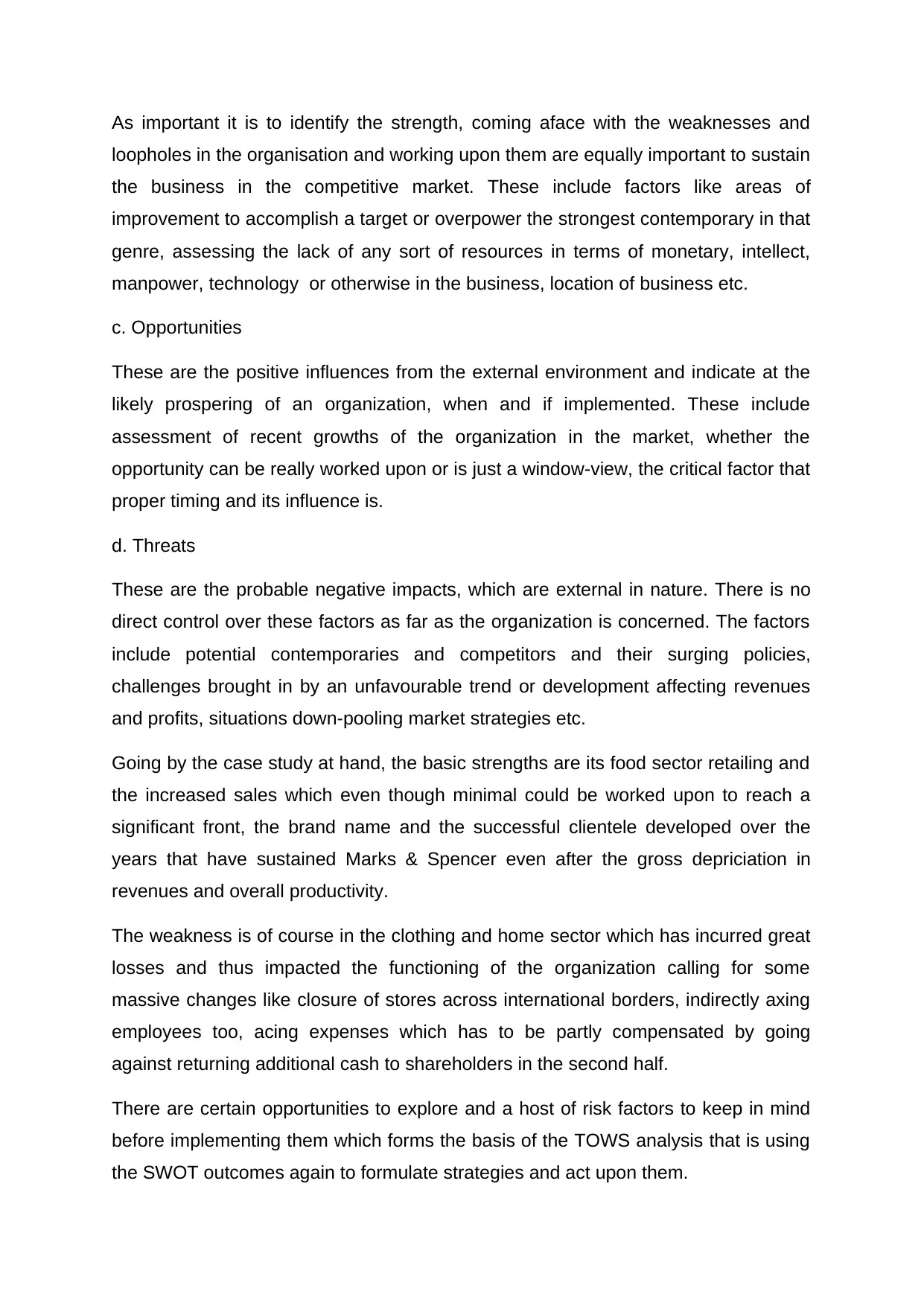
As important it is to identify the strength, coming aface with the weaknesses and
loopholes in the organisation and working upon them are equally important to sustain
the business in the competitive market. These include factors like areas of
improvement to accomplish a target or overpower the strongest contemporary in that
genre, assessing the lack of any sort of resources in terms of monetary, intellect,
manpower, technology or otherwise in the business, location of business etc.
c. Opportunities
These are the positive influences from the external environment and indicate at the
likely prospering of an organization, when and if implemented. These include
assessment of recent growths of the organization in the market, whether the
opportunity can be really worked upon or is just a window-view, the critical factor that
proper timing and its influence is.
d. Threats
These are the probable negative impacts, which are external in nature. There is no
direct control over these factors as far as the organization is concerned. The factors
include potential contemporaries and competitors and their surging policies,
challenges brought in by an unfavourable trend or development affecting revenues
and profits, situations down-pooling market strategies etc.
Going by the case study at hand, the basic strengths are its food sector retailing and
the increased sales which even though minimal could be worked upon to reach a
significant front, the brand name and the successful clientele developed over the
years that have sustained Marks & Spencer even after the gross depriciation in
revenues and overall productivity.
The weakness is of course in the clothing and home sector which has incurred great
losses and thus impacted the functioning of the organization calling for some
massive changes like closure of stores across international borders, indirectly axing
employees too, acing expenses which has to be partly compensated by going
against returning additional cash to shareholders in the second half.
There are certain opportunities to explore and a host of risk factors to keep in mind
before implementing them which forms the basis of the TOWS analysis that is using
the SWOT outcomes again to formulate strategies and act upon them.
loopholes in the organisation and working upon them are equally important to sustain
the business in the competitive market. These include factors like areas of
improvement to accomplish a target or overpower the strongest contemporary in that
genre, assessing the lack of any sort of resources in terms of monetary, intellect,
manpower, technology or otherwise in the business, location of business etc.
c. Opportunities
These are the positive influences from the external environment and indicate at the
likely prospering of an organization, when and if implemented. These include
assessment of recent growths of the organization in the market, whether the
opportunity can be really worked upon or is just a window-view, the critical factor that
proper timing and its influence is.
d. Threats
These are the probable negative impacts, which are external in nature. There is no
direct control over these factors as far as the organization is concerned. The factors
include potential contemporaries and competitors and their surging policies,
challenges brought in by an unfavourable trend or development affecting revenues
and profits, situations down-pooling market strategies etc.
Going by the case study at hand, the basic strengths are its food sector retailing and
the increased sales which even though minimal could be worked upon to reach a
significant front, the brand name and the successful clientele developed over the
years that have sustained Marks & Spencer even after the gross depriciation in
revenues and overall productivity.
The weakness is of course in the clothing and home sector which has incurred great
losses and thus impacted the functioning of the organization calling for some
massive changes like closure of stores across international borders, indirectly axing
employees too, acing expenses which has to be partly compensated by going
against returning additional cash to shareholders in the second half.
There are certain opportunities to explore and a host of risk factors to keep in mind
before implementing them which forms the basis of the TOWS analysis that is using
the SWOT outcomes again to formulate strategies and act upon them.
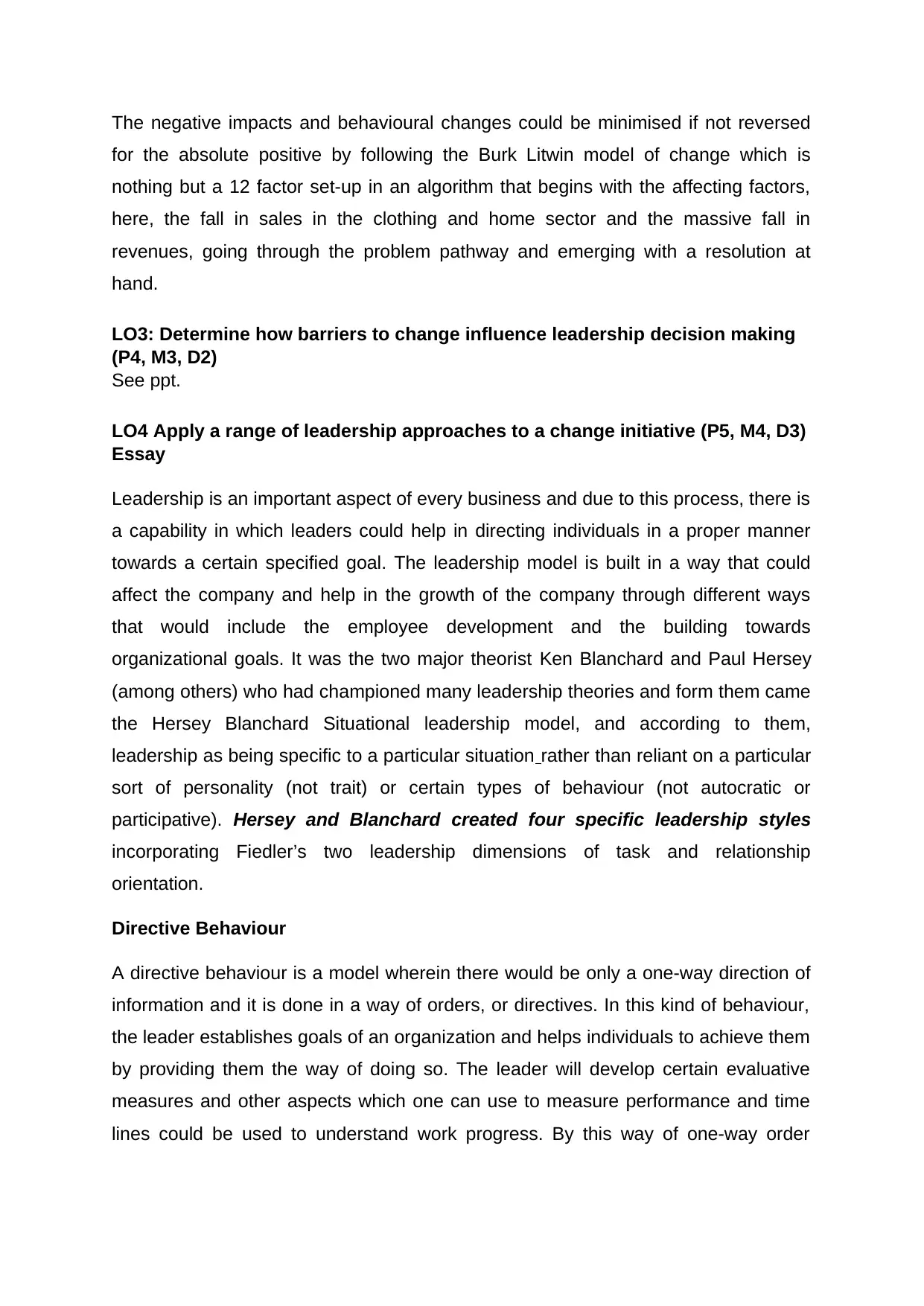
The negative impacts and behavioural changes could be minimised if not reversed
for the absolute positive by following the Burk Litwin model of change which is
nothing but a 12 factor set-up in an algorithm that begins with the affecting factors,
here, the fall in sales in the clothing and home sector and the massive fall in
revenues, going through the problem pathway and emerging with a resolution at
hand.
LO3: Determine how barriers to change influence leadership decision making
(P4, M3, D2)
See ppt.
LO4 Apply a range of leadership approaches to a change initiative (P5, M4, D3)
Essay
Leadership is an important aspect of every business and due to this process, there is
a capability in which leaders could help in directing individuals in a proper manner
towards a certain specified goal. The leadership model is built in a way that could
affect the company and help in the growth of the company through different ways
that would include the employee development and the building towards
organizational goals. It was the two major theorist Ken Blanchard and Paul Hersey
(among others) who had championed many leadership theories and form them came
the Hersey Blanchard Situational leadership model, and according to them,
leadership as being specific to a particular situation rather than reliant on a particular
sort of personality (not trait) or certain types of behaviour (not autocratic or
participative). Hersey and Blanchard created four specific leadership styles
incorporating Fiedler’s two leadership dimensions of task and relationship
orientation.
Directive Behaviour
A directive behaviour is a model wherein there would be only a one-way direction of
information and it is done in a way of orders, or directives. In this kind of behaviour,
the leader establishes goals of an organization and helps individuals to achieve them
by providing them the way of doing so. The leader will develop certain evaluative
measures and other aspects which one can use to measure performance and time
lines could be used to understand work progress. By this way of one-way order
for the absolute positive by following the Burk Litwin model of change which is
nothing but a 12 factor set-up in an algorithm that begins with the affecting factors,
here, the fall in sales in the clothing and home sector and the massive fall in
revenues, going through the problem pathway and emerging with a resolution at
hand.
LO3: Determine how barriers to change influence leadership decision making
(P4, M3, D2)
See ppt.
LO4 Apply a range of leadership approaches to a change initiative (P5, M4, D3)
Essay
Leadership is an important aspect of every business and due to this process, there is
a capability in which leaders could help in directing individuals in a proper manner
towards a certain specified goal. The leadership model is built in a way that could
affect the company and help in the growth of the company through different ways
that would include the employee development and the building towards
organizational goals. It was the two major theorist Ken Blanchard and Paul Hersey
(among others) who had championed many leadership theories and form them came
the Hersey Blanchard Situational leadership model, and according to them,
leadership as being specific to a particular situation rather than reliant on a particular
sort of personality (not trait) or certain types of behaviour (not autocratic or
participative). Hersey and Blanchard created four specific leadership styles
incorporating Fiedler’s two leadership dimensions of task and relationship
orientation.
Directive Behaviour
A directive behaviour is a model wherein there would be only a one-way direction of
information and it is done in a way of orders, or directives. In this kind of behaviour,
the leader establishes goals of an organization and helps individuals to achieve them
by providing them the way of doing so. The leader will develop certain evaluative
measures and other aspects which one can use to measure performance and time
lines could be used to understand work progress. By this way of one-way order
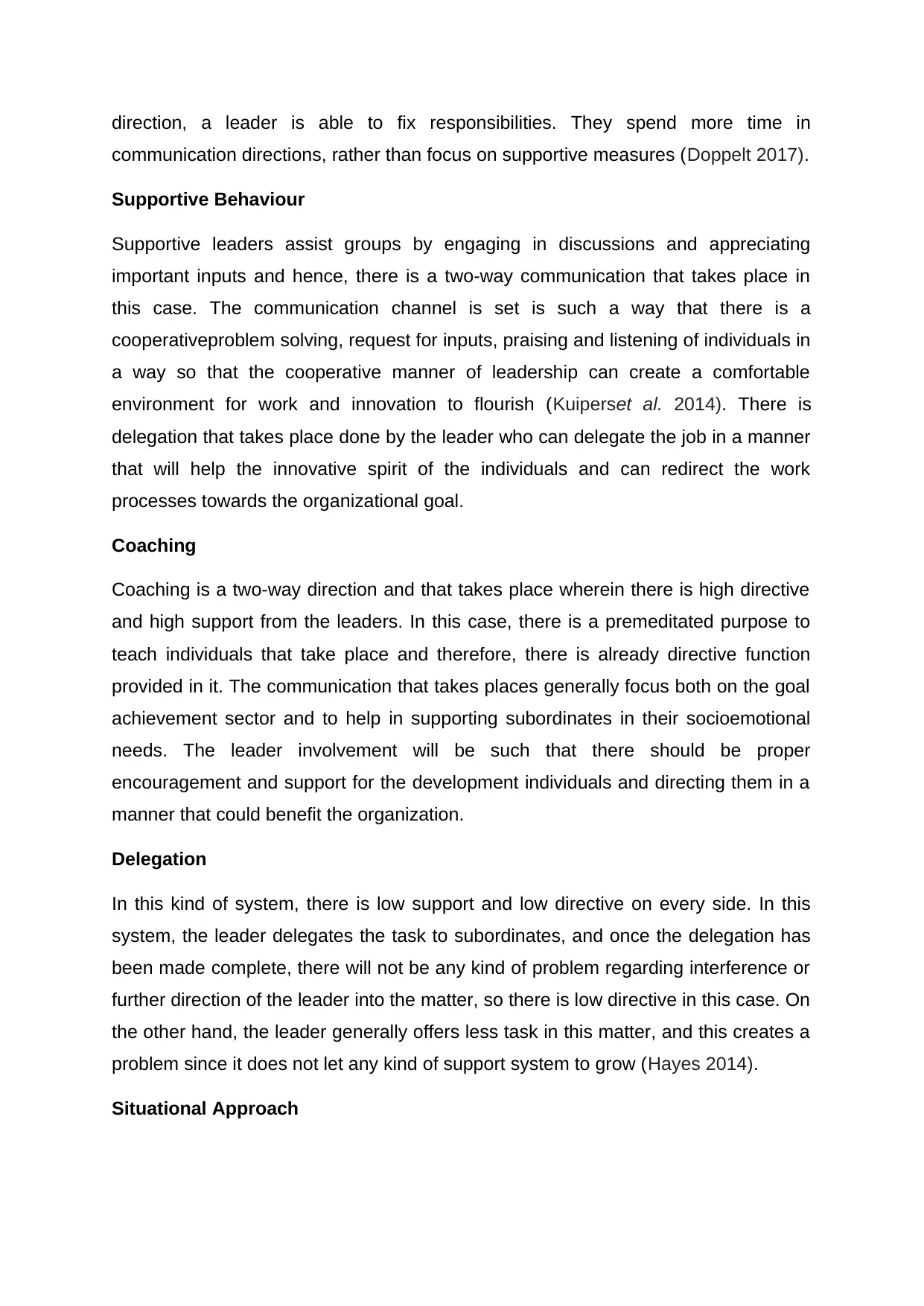
direction, a leader is able to fix responsibilities. They spend more time in
communication directions, rather than focus on supportive measures (Doppelt 2017).
Supportive Behaviour
Supportive leaders assist groups by engaging in discussions and appreciating
important inputs and hence, there is a two-way communication that takes place in
this case. The communication channel is set is such a way that there is a
cooperativeproblem solving, request for inputs, praising and listening of individuals in
a way so that the cooperative manner of leadership can create a comfortable
environment for work and innovation to flourish (Kuiperset al. 2014). There is
delegation that takes place done by the leader who can delegate the job in a manner
that will help the innovative spirit of the individuals and can redirect the work
processes towards the organizational goal.
Coaching
Coaching is a two-way direction and that takes place wherein there is high directive
and high support from the leaders. In this case, there is a premeditated purpose to
teach individuals that take place and therefore, there is already directive function
provided in it. The communication that takes places generally focus both on the goal
achievement sector and to help in supporting subordinates in their socioemotional
needs. The leader involvement will be such that there should be proper
encouragement and support for the development individuals and directing them in a
manner that could benefit the organization.
Delegation
In this kind of system, there is low support and low directive on every side. In this
system, the leader delegates the task to subordinates, and once the delegation has
been made complete, there will not be any kind of problem regarding interference or
further direction of the leader into the matter, so there is low directive in this case. On
the other hand, the leader generally offers less task in this matter, and this creates a
problem since it does not let any kind of support system to grow (Hayes 2014).
Situational Approach
communication directions, rather than focus on supportive measures (Doppelt 2017).
Supportive Behaviour
Supportive leaders assist groups by engaging in discussions and appreciating
important inputs and hence, there is a two-way communication that takes place in
this case. The communication channel is set is such a way that there is a
cooperativeproblem solving, request for inputs, praising and listening of individuals in
a way so that the cooperative manner of leadership can create a comfortable
environment for work and innovation to flourish (Kuiperset al. 2014). There is
delegation that takes place done by the leader who can delegate the job in a manner
that will help the innovative spirit of the individuals and can redirect the work
processes towards the organizational goal.
Coaching
Coaching is a two-way direction and that takes place wherein there is high directive
and high support from the leaders. In this case, there is a premeditated purpose to
teach individuals that take place and therefore, there is already directive function
provided in it. The communication that takes places generally focus both on the goal
achievement sector and to help in supporting subordinates in their socioemotional
needs. The leader involvement will be such that there should be proper
encouragement and support for the development individuals and directing them in a
manner that could benefit the organization.
Delegation
In this kind of system, there is low support and low directive on every side. In this
system, the leader delegates the task to subordinates, and once the delegation has
been made complete, there will not be any kind of problem regarding interference or
further direction of the leader into the matter, so there is low directive in this case. On
the other hand, the leader generally offers less task in this matter, and this creates a
problem since it does not let any kind of support system to grow (Hayes 2014).
Situational Approach
Paraphrase This Document
Need a fresh take? Get an instant paraphrase of this document with our AI Paraphraser
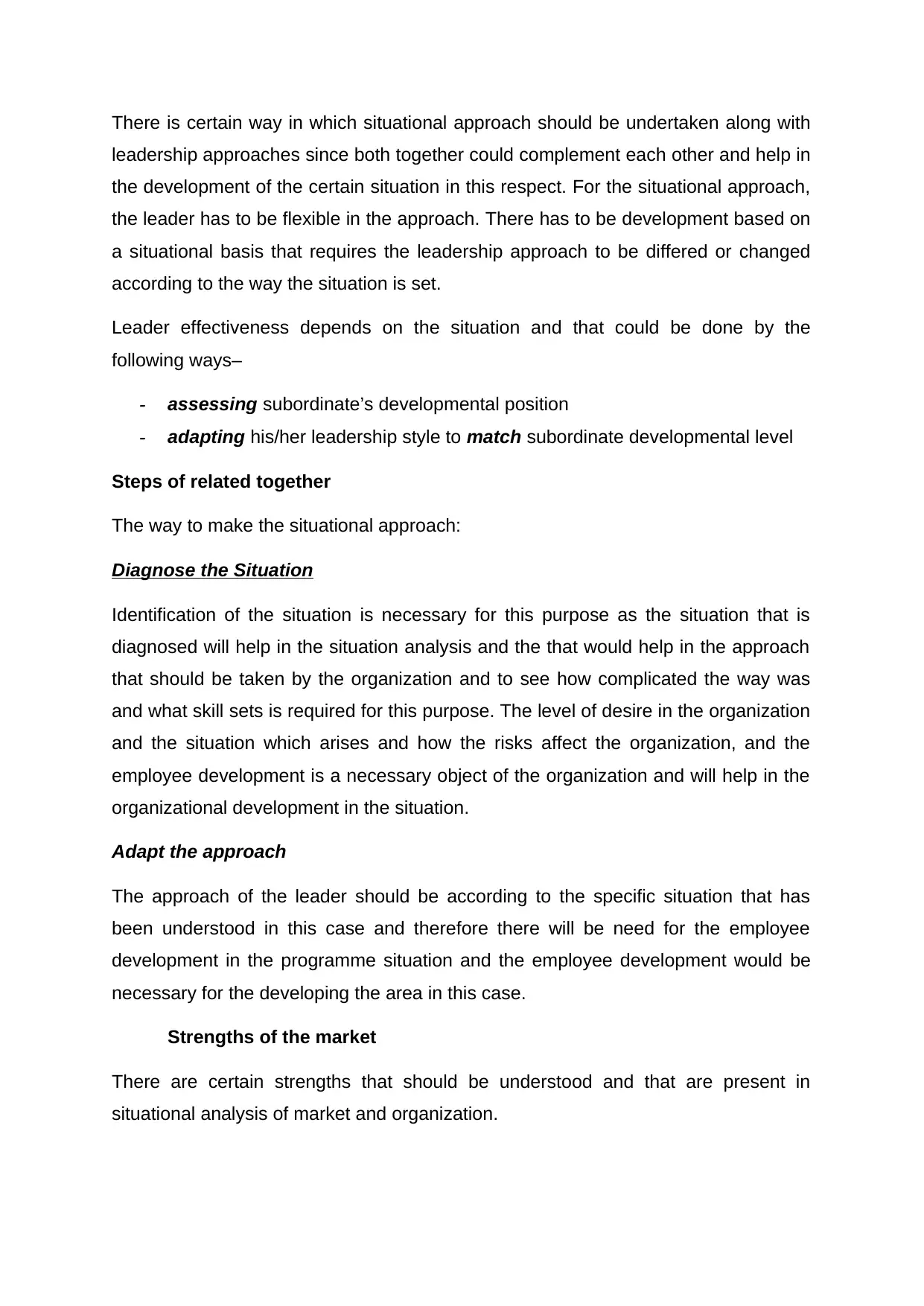
There is certain way in which situational approach should be undertaken along with
leadership approaches since both together could complement each other and help in
the development of the certain situation in this respect. For the situational approach,
the leader has to be flexible in the approach. There has to be development based on
a situational basis that requires the leadership approach to be differed or changed
according to the way the situation is set.
Leader effectiveness depends on the situation and that could be done by the
following ways–
- assessing subordinate’s developmental position
- adapting his/her leadership style to match subordinate developmental level
Steps of related together
The way to make the situational approach:
Diagnose the Situation
Identification of the situation is necessary for this purpose as the situation that is
diagnosed will help in the situation analysis and the that would help in the approach
that should be taken by the organization and to see how complicated the way was
and what skill sets is required for this purpose. The level of desire in the organization
and the situation which arises and how the risks affect the organization, and the
employee development is a necessary object of the organization and will help in the
organizational development in the situation.
Adapt the approach
The approach of the leader should be according to the specific situation that has
been understood in this case and therefore there will be need for the employee
development in the programme situation and the employee development would be
necessary for the developing the area in this case.
Strengths of the market
There are certain strengths that should be understood and that are present in
situational analysis of market and organization.
leadership approaches since both together could complement each other and help in
the development of the certain situation in this respect. For the situational approach,
the leader has to be flexible in the approach. There has to be development based on
a situational basis that requires the leadership approach to be differed or changed
according to the way the situation is set.
Leader effectiveness depends on the situation and that could be done by the
following ways–
- assessing subordinate’s developmental position
- adapting his/her leadership style to match subordinate developmental level
Steps of related together
The way to make the situational approach:
Diagnose the Situation
Identification of the situation is necessary for this purpose as the situation that is
diagnosed will help in the situation analysis and the that would help in the approach
that should be taken by the organization and to see how complicated the way was
and what skill sets is required for this purpose. The level of desire in the organization
and the situation which arises and how the risks affect the organization, and the
employee development is a necessary object of the organization and will help in the
organizational development in the situation.
Adapt the approach
The approach of the leader should be according to the specific situation that has
been understood in this case and therefore there will be need for the employee
development in the programme situation and the employee development would be
necessary for the developing the area in this case.
Strengths of the market
There are certain strengths that should be understood and that are present in
situational analysis of market and organization.
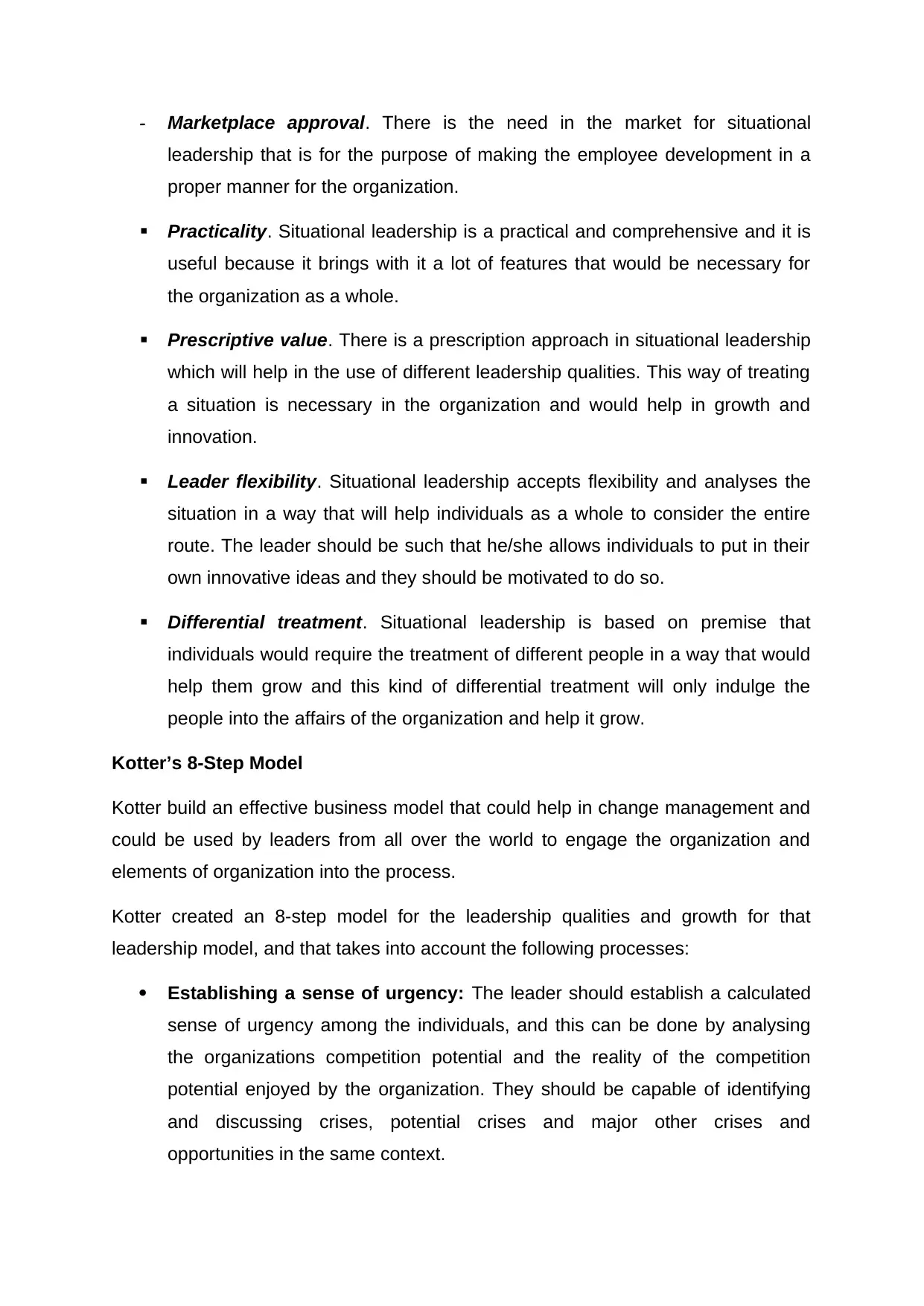
- Marketplace approval. There is the need in the market for situational
leadership that is for the purpose of making the employee development in a
proper manner for the organization.
Practicality. Situational leadership is a practical and comprehensive and it is
useful because it brings with it a lot of features that would be necessary for
the organization as a whole.
Prescriptive value. There is a prescription approach in situational leadership
which will help in the use of different leadership qualities. This way of treating
a situation is necessary in the organization and would help in growth and
innovation.
Leader flexibility. Situational leadership accepts flexibility and analyses the
situation in a way that will help individuals as a whole to consider the entire
route. The leader should be such that he/she allows individuals to put in their
own innovative ideas and they should be motivated to do so.
Differential treatment. Situational leadership is based on premise that
individuals would require the treatment of different people in a way that would
help them grow and this kind of differential treatment will only indulge the
people into the affairs of the organization and help it grow.
Kotter’s 8-Step Model
Kotter build an effective business model that could help in change management and
could be used by leaders from all over the world to engage the organization and
elements of organization into the process.
Kotter created an 8-step model for the leadership qualities and growth for that
leadership model, and that takes into account the following processes:
Establishing a sense of urgency: The leader should establish a calculated
sense of urgency among the individuals, and this can be done by analysing
the organizations competition potential and the reality of the competition
potential enjoyed by the organization. They should be capable of identifying
and discussing crises, potential crises and major other crises and
opportunities in the same context.
leadership that is for the purpose of making the employee development in a
proper manner for the organization.
Practicality. Situational leadership is a practical and comprehensive and it is
useful because it brings with it a lot of features that would be necessary for
the organization as a whole.
Prescriptive value. There is a prescription approach in situational leadership
which will help in the use of different leadership qualities. This way of treating
a situation is necessary in the organization and would help in growth and
innovation.
Leader flexibility. Situational leadership accepts flexibility and analyses the
situation in a way that will help individuals as a whole to consider the entire
route. The leader should be such that he/she allows individuals to put in their
own innovative ideas and they should be motivated to do so.
Differential treatment. Situational leadership is based on premise that
individuals would require the treatment of different people in a way that would
help them grow and this kind of differential treatment will only indulge the
people into the affairs of the organization and help it grow.
Kotter’s 8-Step Model
Kotter build an effective business model that could help in change management and
could be used by leaders from all over the world to engage the organization and
elements of organization into the process.
Kotter created an 8-step model for the leadership qualities and growth for that
leadership model, and that takes into account the following processes:
Establishing a sense of urgency: The leader should establish a calculated
sense of urgency among the individuals, and this can be done by analysing
the organizations competition potential and the reality of the competition
potential enjoyed by the organization. They should be capable of identifying
and discussing crises, potential crises and major other crises and
opportunities in the same context.
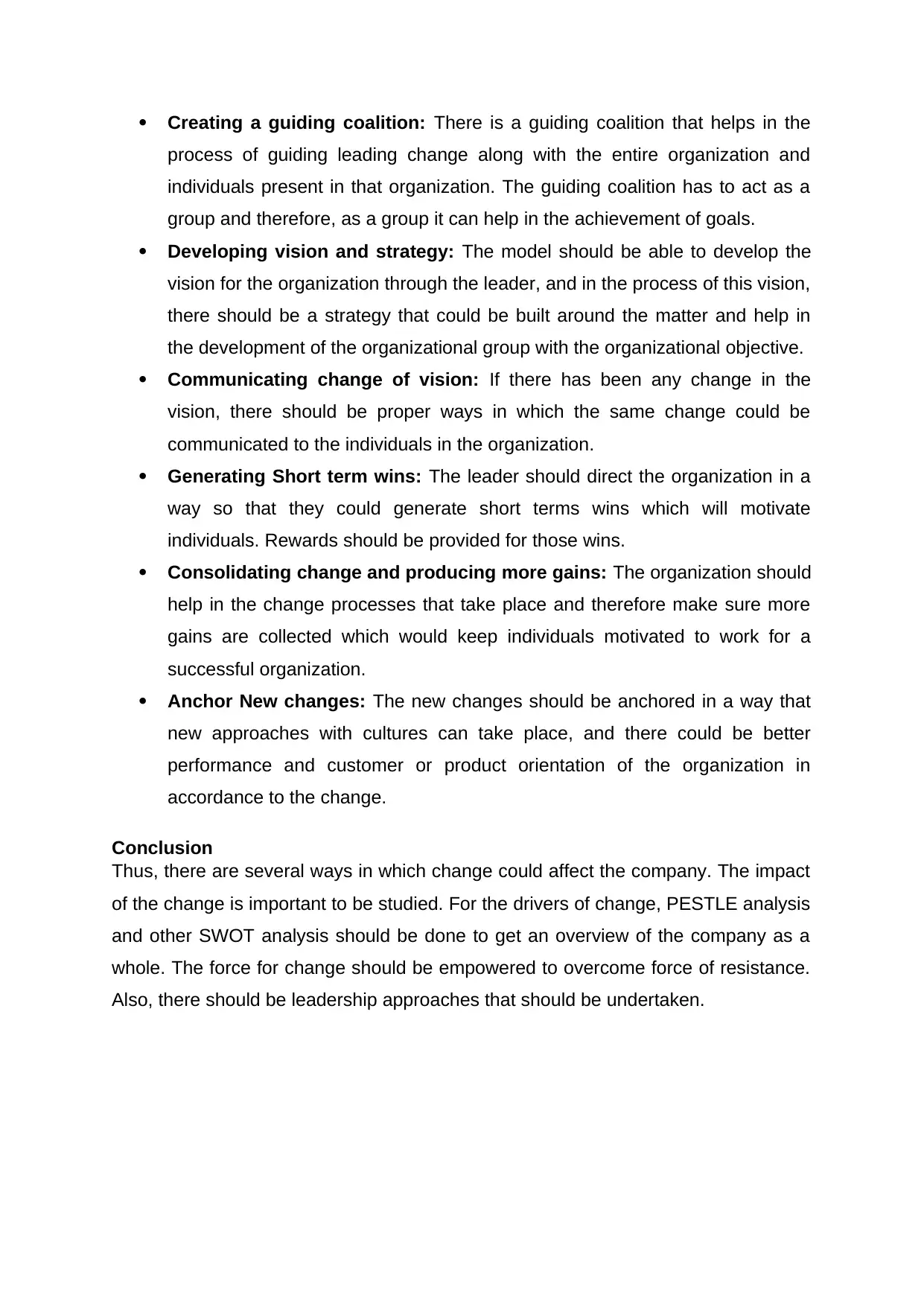
Creating a guiding coalition: There is a guiding coalition that helps in the
process of guiding leading change along with the entire organization and
individuals present in that organization. The guiding coalition has to act as a
group and therefore, as a group it can help in the achievement of goals.
Developing vision and strategy: The model should be able to develop the
vision for the organization through the leader, and in the process of this vision,
there should be a strategy that could be built around the matter and help in
the development of the organizational group with the organizational objective.
Communicating change of vision: If there has been any change in the
vision, there should be proper ways in which the same change could be
communicated to the individuals in the organization.
Generating Short term wins: The leader should direct the organization in a
way so that they could generate short terms wins which will motivate
individuals. Rewards should be provided for those wins.
Consolidating change and producing more gains: The organization should
help in the change processes that take place and therefore make sure more
gains are collected which would keep individuals motivated to work for a
successful organization.
Anchor New changes: The new changes should be anchored in a way that
new approaches with cultures can take place, and there could be better
performance and customer or product orientation of the organization in
accordance to the change.
Conclusion
Thus, there are several ways in which change could affect the company. The impact
of the change is important to be studied. For the drivers of change, PESTLE analysis
and other SWOT analysis should be done to get an overview of the company as a
whole. The force for change should be empowered to overcome force of resistance.
Also, there should be leadership approaches that should be undertaken.
process of guiding leading change along with the entire organization and
individuals present in that organization. The guiding coalition has to act as a
group and therefore, as a group it can help in the achievement of goals.
Developing vision and strategy: The model should be able to develop the
vision for the organization through the leader, and in the process of this vision,
there should be a strategy that could be built around the matter and help in
the development of the organizational group with the organizational objective.
Communicating change of vision: If there has been any change in the
vision, there should be proper ways in which the same change could be
communicated to the individuals in the organization.
Generating Short term wins: The leader should direct the organization in a
way so that they could generate short terms wins which will motivate
individuals. Rewards should be provided for those wins.
Consolidating change and producing more gains: The organization should
help in the change processes that take place and therefore make sure more
gains are collected which would keep individuals motivated to work for a
successful organization.
Anchor New changes: The new changes should be anchored in a way that
new approaches with cultures can take place, and there could be better
performance and customer or product orientation of the organization in
accordance to the change.
Conclusion
Thus, there are several ways in which change could affect the company. The impact
of the change is important to be studied. For the drivers of change, PESTLE analysis
and other SWOT analysis should be done to get an overview of the company as a
whole. The force for change should be empowered to overcome force of resistance.
Also, there should be leadership approaches that should be undertaken.
Secure Best Marks with AI Grader
Need help grading? Try our AI Grader for instant feedback on your assignments.
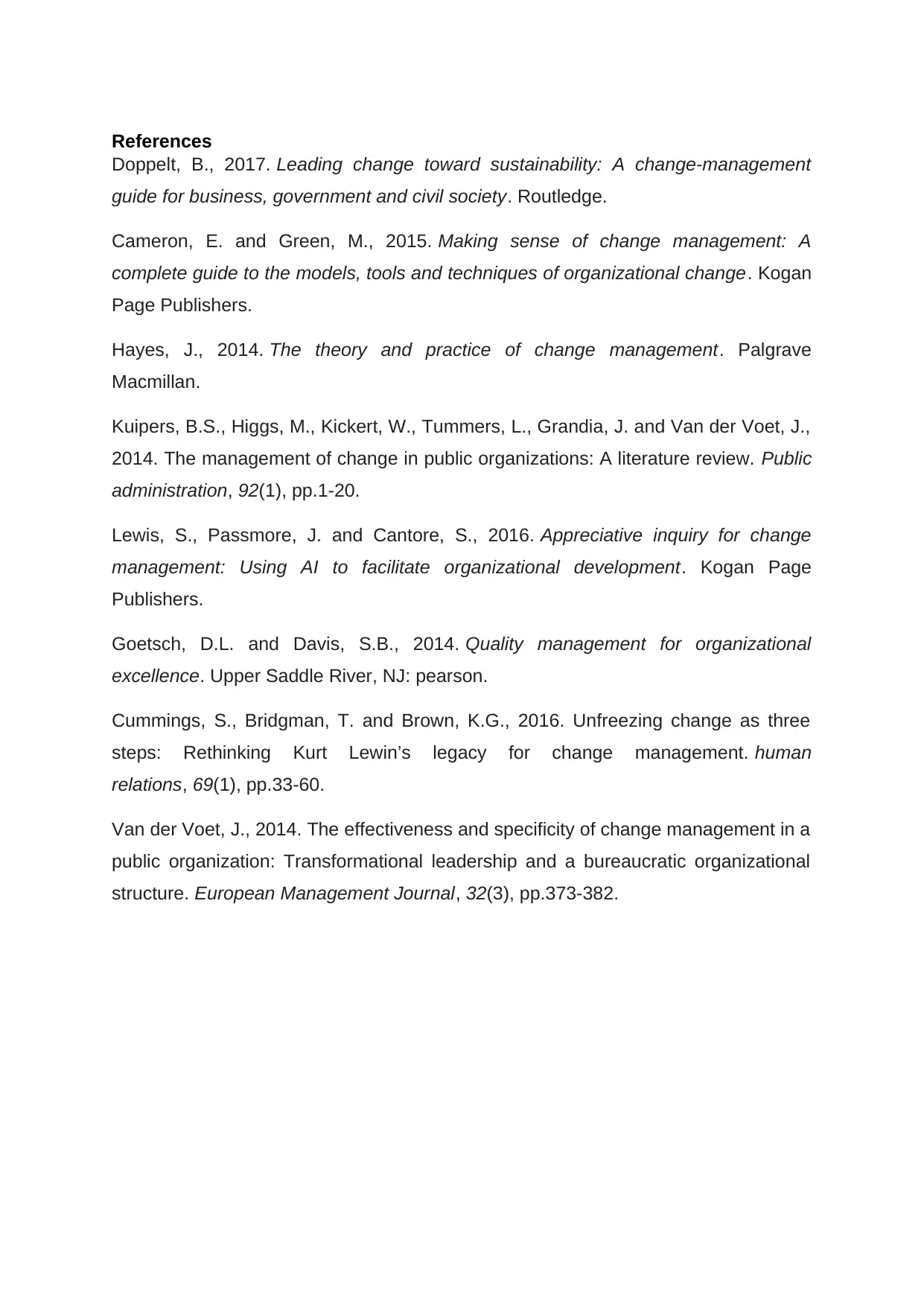
References
Doppelt, B., 2017. Leading change toward sustainability: A change-management
guide for business, government and civil society. Routledge.
Cameron, E. and Green, M., 2015. Making sense of change management: A
complete guide to the models, tools and techniques of organizational change. Kogan
Page Publishers.
Hayes, J., 2014. The theory and practice of change management. Palgrave
Macmillan.
Kuipers, B.S., Higgs, M., Kickert, W., Tummers, L., Grandia, J. and Van der Voet, J.,
2014. The management of change in public organizations: A literature review. Public
administration, 92(1), pp.1-20.
Lewis, S., Passmore, J. and Cantore, S., 2016. Appreciative inquiry for change
management: Using AI to facilitate organizational development. Kogan Page
Publishers.
Goetsch, D.L. and Davis, S.B., 2014. Quality management for organizational
excellence. Upper Saddle River, NJ: pearson.
Cummings, S., Bridgman, T. and Brown, K.G., 2016. Unfreezing change as three
steps: Rethinking Kurt Lewin’s legacy for change management. human
relations, 69(1), pp.33-60.
Van der Voet, J., 2014. The effectiveness and specificity of change management in a
public organization: Transformational leadership and a bureaucratic organizational
structure. European Management Journal, 32(3), pp.373-382.
Doppelt, B., 2017. Leading change toward sustainability: A change-management
guide for business, government and civil society. Routledge.
Cameron, E. and Green, M., 2015. Making sense of change management: A
complete guide to the models, tools and techniques of organizational change. Kogan
Page Publishers.
Hayes, J., 2014. The theory and practice of change management. Palgrave
Macmillan.
Kuipers, B.S., Higgs, M., Kickert, W., Tummers, L., Grandia, J. and Van der Voet, J.,
2014. The management of change in public organizations: A literature review. Public
administration, 92(1), pp.1-20.
Lewis, S., Passmore, J. and Cantore, S., 2016. Appreciative inquiry for change
management: Using AI to facilitate organizational development. Kogan Page
Publishers.
Goetsch, D.L. and Davis, S.B., 2014. Quality management for organizational
excellence. Upper Saddle River, NJ: pearson.
Cummings, S., Bridgman, T. and Brown, K.G., 2016. Unfreezing change as three
steps: Rethinking Kurt Lewin’s legacy for change management. human
relations, 69(1), pp.33-60.
Van der Voet, J., 2014. The effectiveness and specificity of change management in a
public organization: Transformational leadership and a bureaucratic organizational
structure. European Management Journal, 32(3), pp.373-382.
1 out of 17
Related Documents
Your All-in-One AI-Powered Toolkit for Academic Success.
+13062052269
info@desklib.com
Available 24*7 on WhatsApp / Email
![[object Object]](/_next/static/media/star-bottom.7253800d.svg)
Unlock your academic potential
© 2024 | Zucol Services PVT LTD | All rights reserved.



